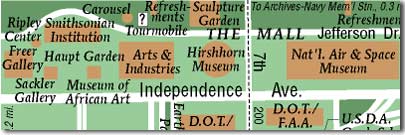The Map is Not the Territory*
By Hans Christian von Baeyer

Adapted from the essay "Two-Way Street," published in The Sciences, Nov./Dec. 1990.
My uncle Karl had no sense of direction. Armed with an elaborate set of instructions and a street map of downtown Montreal, he would gamely set off on an errand, and we children would gleefully brace ourselves for the next development. Three-quarters of an hour later, without fail, the telephone would ring. My aunt Lotte, cursing under her breath, would have to interrupt whatever she was doing, borrow a neighbor's car and drive out to some forlorn suburb to rescue Uncle Karl. It wasn't that he was stupid. Far from it: he was a successful psychiatrist, an accomplished musician, and a best-selling autobiographer. He just couldn't read a map.
Not everyone has a gift for orienteering. It requires more than mere literacy (which my uncle clearly possessed) and adequate powers of observation (he was, after all, trained to observe people). Reading maps takes a special knack for relating real territory to its symbolic representation: imagining the steepness of a hiking trail from the spacing of the contour lines of a topographic map or, conversely, fixing your position of the map based on your first glimpse of a power line over the brow of a hill. To make such connections you have to shuttle between two levels of reality. The pursuit of physics demands similar skill: the ability to shuttle effortlessly between two very different modes of thinking. And therein lies its chief difficulty.
When physics students are asked why they did badly on a test, they often reply, "I understand the concepts, but I can't do the math." A look at their papers would seem to bear them out. The most elementary mathematical conventions are broken and the simplest operations botched. But the experienced teacher knows that the mathematical errors are a symptom, not the cause of the difficulty. Students who fail physics often do quite well in mathematics. They can readily manipulate the symbols, but they cannot bring them to bear on physical concepts.
In fact, confronted with this challenge, students forget familiar mathematical skills. Teachers of writing see much the same thing: When students try to cope with complex ideas, the first thing to go is their basic writing skill. In the struggle to express thoughts not yet fully articulated, punctuation breaks down, even spelling falters. The student who can write a witty and lucid essay about his cat is reduced to near illiteracy in his analysis of the concept of justice in King Lear. His problem is not with writing per se, nor with understanding Shakespeare, but with merging his appreciation of the play with the discipline of writing. It is Uncle Karl's problem again: moving between two planes of reality.
Uncle Karl's trouble with maps is a metaphor for what gives physics its reputation for difficulty. Physics deals on the one hand with the rich texture of the real, inanimate world and on the other with the abstract, logical formalism of mathematics. Each study by itself hold no particular terrors. Everyone is inescapably engaged in the world that physics describes, be it in driving a car, cooking a steak, or hitting a nail. Many people are also comfortable with highly abstract systems of discourse -- the languages of mathematics, computing, musical composition, and chess. But physics, more than any other science, is firmly rooted in both the actual and the symbolic worlds, and it requires its students to shift between them continually. Good physics teaching demands an appreciation of this fact.
Contrast the usual image of a car with a physicist's picture. Most people envision an object of steel and glass and chrome and rubber; they picture it moving through its surroundings, and they have a good intuitive notion of its speed. Physicists share this picture, but they also see in their mind's eye an altogether different thing. The body of the car is reduced to a mere point, and the point bristles with arrows -- vectors with continually changing directions and lengths. They represent velocity, acceleration, weight, tire friction, air resistance, momentum, the relative velocity with respect to a passing bus and so many more that the whole thing resembles a porcupine with elastic quills.
Physicists have no trouble keeping in mind both the car and the porcupine, shifting effortlessly between the two. But is it any wonder that this trick may be difficult to learn? When students come to my office to fret about a poor performance on some test, I often tell them about my uncle Karl. Understanding the root of their problem can help to put them on the road to improvement.
* The title is attributed to the American philosopher Alfred Skorzybski
Hans Christian von Baeyer is Chancellor Professor of Physics College of William and Mary, Williamsburg, VA.
See a listing of his books on amazon.com.











